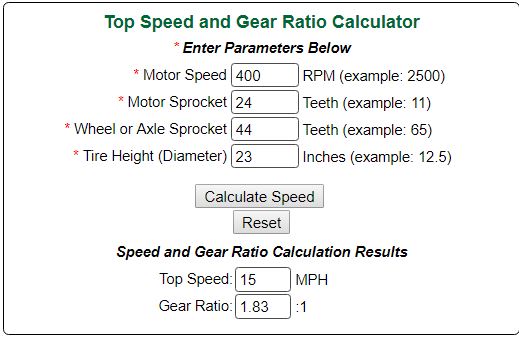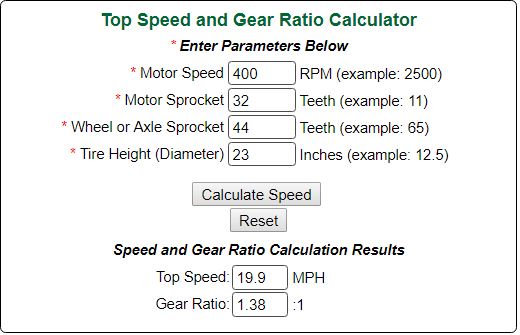Hugh-Jassman
1 kW
- Joined
- Jun 20, 2015
- Messages
- 407
I am still trying to find the rpms at the wheel. I think the chain I use is going to need to be shiftabe, at least untill I know if I need only one speed or two.
If I can get by with only one then a bushing chain would be best for sure.
RPM's
If the cyclone 3000 planetary gear ratio is 6:1 and using a 32 sprocket chainring to drive the 34 sprocket on the rear hub, what is the total combined gear reduction?
9.33:1 should be more than enough for 450lbs (total combined weight) on a 9%grade. but that is not what teh ratio is.
The ratio is 6.375:1 with a 32 to the 34, because I have to multiply the 6:1 by the second ratio.
Which would give my 23” tire 25.9 mph at 400 motor output rpms?
If I were to use a 44 sprocket on the rear and 32 on the front it would still be only about 20mph.
So I definitely need a lower gear: 1.83x6=10.99:1 ratio with the 24sprocket on the front. For about 15mph.
It looks like I will have to use the 36 and 24t sprockets on the crank. With a 44t on the rear. To get the ratio close enough to the target of 1300w and 13mph on the 9%grade.
That means I need a shiftable chain (front only).....
If I were to use a 36 volt battery I would get a lower RPM,What would the rpm be at 1300watts? But what are the cons of a lower voltage? Would the battery act the same when draining 1600w out for the1300w output because it would be sucking more amps???


Too bad no one has made a performance graph for this motor.
If I can get by with only one then a bushing chain would be best for sure.
RPM's
If the cyclone 3000 planetary gear ratio is 6:1 and using a 32 sprocket chainring to drive the 34 sprocket on the rear hub, what is the total combined gear reduction?
9.33:1 should be more than enough for 450lbs (total combined weight) on a 9%grade. but that is not what teh ratio is.
The ratio is 6.375:1 with a 32 to the 34, because I have to multiply the 6:1 by the second ratio.
Which would give my 23” tire 25.9 mph at 400 motor output rpms?
If I were to use a 44 sprocket on the rear and 32 on the front it would still be only about 20mph.
So I definitely need a lower gear: 1.83x6=10.99:1 ratio with the 24sprocket on the front. For about 15mph.
It looks like I will have to use the 36 and 24t sprockets on the crank. With a 44t on the rear. To get the ratio close enough to the target of 1300w and 13mph on the 9%grade.
That means I need a shiftable chain (front only).....
If I were to use a 36 volt battery I would get a lower RPM,What would the rpm be at 1300watts? But what are the cons of a lower voltage? Would the battery act the same when draining 1600w out for the1300w output because it would be sucking more amps???
Too bad no one has made a performance graph for this motor.

